Livin’ the Dream
I’ve had a tough time writing about life on the border these past weeks. Maybe it is the intense heat. We are on the cusp of the monsoon season, and temperatures are triple digits. Humidity is rising. Instead of the famed Arizona “dry heat”, there is plenty of sweat these days. A haze of green fuzz on the desert floor from an early rain last week covers the surrounding landscape and I hope it is the prelude to a torrential monsoon. But there is always a sense of guarded optimism before the monsoon season. Will the rains pour buckets over my desert home and give blessed relief, or will it pass me by?
When President Obama announced last week that Homeland Security would stop automatically deporting young undocumented immigrants and grant them work permits, I was delighted. But I remain guarded about all the jubilation and hoopla. I don’t want to get my hopes up. The DREAM Act (Development, Relief, and Education for Alien Minors) targets undocumented immigrants who came to the U.S. before they were 16, and have lived in this country for more than five straight years, staying in school and out of trouble. Hundreds of thousands of young people could benefit from this. I have met many “DREAM kids” over the past year at the comedor. They are kids in college, in high school, some married with families and working at jobs they enjoy. Many were not aware they were undocumented. They consider the United States their home.
So visiting the comedor this week I looked forward to a positive and uplifting story to tell. I had a fantasy of walking a DREAM kid back into the U.S., waving at ICE and the Customs Officials as we passed through the border check point.
Instead of DREAMers, our little group of Samaritans got a different kind of migrant experience. Four cows were wandering the busy highway heading toward Estados Unidos. They had escaped from a local corral and were determinedly making their way to the customs gates and FREEDOM!! We did our best to help round them up, but alas, their Mexican owners ushered them back to their holding area awaiting shipment to an American stockyard.
I treasured this moment of high jinx and laughter.
Then it was all business.
There were 78 migrants at the comedor on this day, and none of them qualified as a DREAM candidate. This group had never heard of the DREAM Act. Most of the migrants today were farmers and bakers and chefs and distraught parents fleeing parts of Mexico and Central America for economic reasons. Several from Honduras simply said it was too dangerous to stay in their villages.
And here’s what I realized. I dreaded writing yet another tragic story of dashed hopes and unspeakable injury. I was afraid to admit that people don’t want to read about this stuff anymore. I was afraid that today’s group was jumping from the frying pan into the fire of the Sonoran desert in June.
So it was a pleasant surprise when I read the op-ed in the New York Times, “Death in the Desert”, by Ananda Rose, June 22, 2012.
http://www.nytimes.com/2012/06/22/opinion/migrants-dying-on-the-us-mexico-border.html
Maybe someone is paying attention after all. Rose visited the comedor awhile back and validated my own experience about immigration and the perils awaiting those who cross the desert. Illegal immigration numbers may be down, but the numbers of deaths in the desert remain high. Because of a military presence, the Border Patrol, ICE and National Guard troops scouring Arizona for the undocumented, migrants are pushed into remote mountainous areas which are extremely difficult to traverse. They become lost, dehydrated, abandoned, injured, and many of them die.
One gentleman who looked to be in his 40’s has tried to cross into the U.S. four times and has been in and out of detention centers for months. He is a cook at a Mexican restaurant in Alabama where his wife and children live.
“There are harsh laws in Alabama for Mexicans without papers, ” he tells me, limping across the room on blistered feet.
“No more. I’m done crossing. I’m going to Puebla where I was born. I don’t know what else to do.”
He shows me a photo of his daughter in a soccer outfit at an American high school in Alabama. His eyes fill with tears. I suggest that maybe she can come to Puebla and visit him.
He shakes his head and tells me, “She is almost American. Why would she want to do that?”
There are two young children at the comedor today traveling with their aunt. They are from Mexico and the youngsters tell the Samaritans that they are going to New York City to see their Papa.
New York City? Walking to New York City?
I am horrified. Shura, a Samaritan mover and shaker, shows the aunt and children a map. We point to the distance from Nogales to any town or city. We point out the little red dots on the map which indicate deaths. We talk about how many bottles of water per day you need to carry to survive. The kids and aunt don’t hear a thing. The little boy, age 9, draws a picture of his dreams for this journey. He draws himself and the wall at the border. He tells us his Papa lives in a place surrounded by skyscrapers. Both kids look at me with hope and a bravado that defies reason. They are going to see their Papa and the journey will be an adventure. There may be insurmountable barriers, but the aunt (in her 20’s) and the kids are dreaming of skyscrapers.
I heard a few days later that this little trio of pilgrims had indeed crossed and were somewhere in the desert. It was 103 degrees on that day.
And I think about how much I hate this notion of an American dream. It is a killer. It is a fantasy. It gives me nightmares.
There is next to nothing in the local press about lost lives in the desert during these summer months. I’m told that people don’t want to hear about it. And today, I didn’t want to hear about it either. But thanks to Ananda Rose and her excellent op-ed, I am reminded that things are grim for our desert travelers. It may be good news for the “DREAMers”, but there are scores that are left out.
And the fact that there is so little outrage or interest in this tragedy is an element that astounds me. I wrote of Alfonso’s death in my last posting. I found out about this death in a newspaper near San Diego weeks after his body was discovered. It is rare to read of death in the desert in the local news. Why doesn’t 2,025 plus deaths since the year 2000 within 40 miles of my home stir up any interest? What does it take to wake us up to this senseless loss of life? This is happening in our own backyard. What is to become of the hundreds of pilgrims I meet each week? Many that I see and speak with will die a horrible death in the desert. Those that make it will work for lower than minimum wage; many will reunite with their families, but live in the shadows.
Underlying a lot of my frustration is that change in immigration policy drags along at a snail’s pace. I applaud Obama’s proclamation to make life more bearable for the DREAM kids. But honestly, what about the rest? What is so difficult about designing a work permit system for immigrants who wish to do jobs that most Americans refuse to tackle? What is so complicated about allowing easier access back and forth across our borders for Latinos that wish to go home to see family and celebrate holidays?
So in spite of my whining, I’m keeping my hopes up—hopes for an immigration policy that honors life, and hopes for a record monsoon rainy season. And I hope one of those cows made it across the wall.
To find out more about the Green Valley Samaritans, check out our website: www.gvsamaritans.org Your comments, financial support, and dialogue are always appreciated.


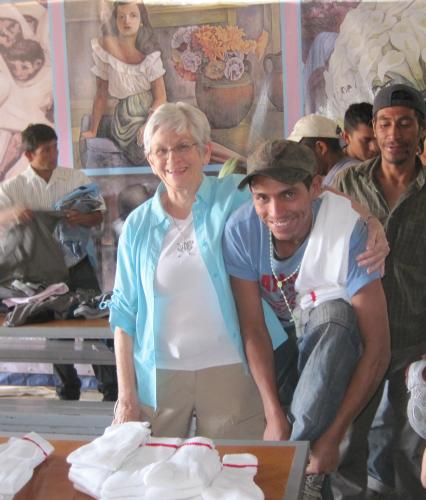
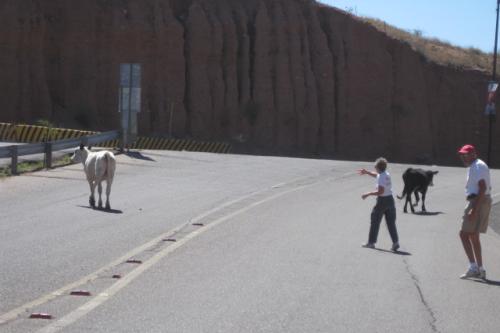
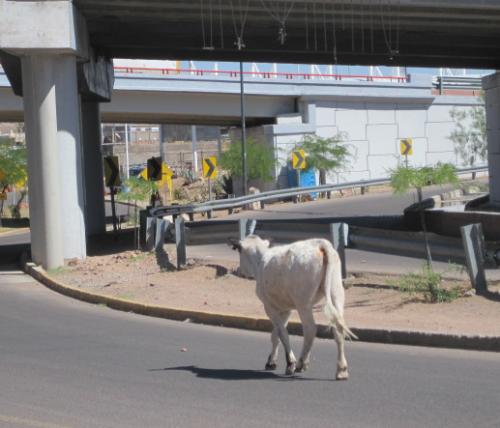
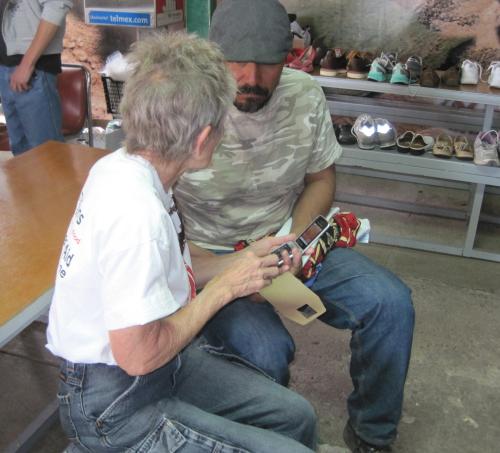
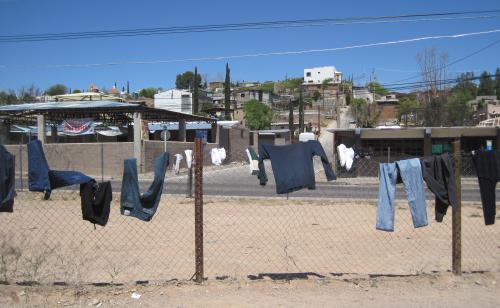
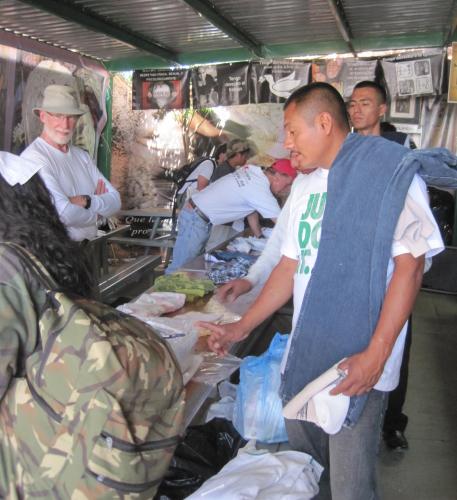
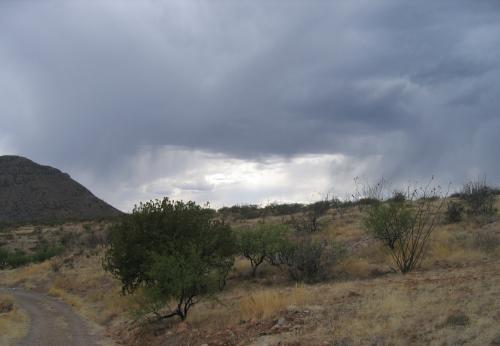

Peg,
It’s always a joy to read your blog, thank you. Your first paragraph nailed the weather and my reaction to it.
Tony
Thanks for getting us updated. My experiences a the Comedor were life changing for me. I hope to keep spreading the word of the tragedy that is occurring at the Border
Love your blog. Keep it up. A thought: most of these folks have a way to earn a living once they get to the states…relatives who’ve promised them a job, jobs they had before they were deported, etc. If we gave people a temporary permit to enter and to go to a job they claimed they had, and a temporary social security number, they could come in legally and look. when they had the job and started paying social security, the card would be made permanent. They’d have to give an intended city and maybe check in with an immigration officer once a month. Ex-border patrol guys would be perfect for that.
then law enforcement could focus on the few who disappeared, and the legal ones could get on with their lives. Of course, the industrial/political complex would have to explain to the american public that we need these people and their offspring to maintain our population growth rate and guarantee our pensions’ expected growth rates…and that this is the cheapest way to do that..
you could help by just noting how many of the “repeat deportees” have and could again have jobs in the US if they were let back in.
John—-great ideas. Thanks for these practical, do-able suggestions. This ain’t rocket science. Your ideas make sense. I see a lot of “repeaters” at the comedor, and will start exploring those stories more and counting the numbers. Onward—Peg
Thanks for sharing Peg. Working with migrants in southern Mexico, I can relate to a lot of the frustration of wanting migrants to turn back because I know how dangerous the journey is. But it also humbling how irrelevant US policy seems here. Not just this week’s news. But any reformed immigration policy. Because the issue is that Honduras, for example, is simply too poor and violent to live in – especially for young, uneducated boys. And so as much as I want a just immigration system, I also have to realize that a just immigration system is never enough. It may be an unhelpful comment, but I guess it is an acknowledgement we have to have as we look towards working to justice in the immigration system.
Thanks Joanna for your dose of reality. You are truly on the front lines in southern Mexico. I admire your perseverance and determination in working with the people coming up from Central America. We see people from Honduras every week. They are a beautiful and strong people and will risk their lives in order to cross into the U.S. and find work. I wish I could know what happens to them. I think about them a lot. Take care of yourself. –Peg
Peg, Your words are so powerful with the stifling complexity of politics for election & the contrast of people’s literal life/death struggle. I just read in the “Seattle Times” yesterday that in Eastern Washington there is such a shortage of farm laborers that asparagus & cherries are NOT being harvested & all the growers are worried that their crops will be lost….the supply of farm workers has dried up…how can this administration be so deaf to the urgent agricultural needs in the WEST…here in Wa. apples, cherries, asparagus, & apricots alone are almost $2,000,0000,000! If there were only a viable work program to utilize migrant workers or workers who could stay 6 months…there is work!!!
I too am discouraged with both political parties, congress people who are refusing to fix the system!
I found this and I thought you’d like it:
http://stuffwhitepeopledo.blogspot.com/2010/06/finally-see-undocumented-immigrants-as.html
Like the author says, a “sliver of optimism.” Hope reading it helps the frustration for a second or two. (It gave me chills!)
Blessings